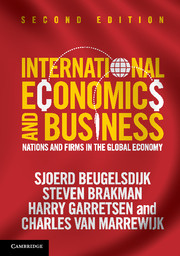Book contents
- Frontmatter
- Contents
- List of figures
- List of tables
- List of boxes
- Preface
- Part I Introduction
- Part II Firms, trade, and location
- 3 Trade, comparative advantage, and competition
- 4 Modern trade theory: the role of the firm
- 5 Trade restrictions and trade policy
- 6 Firms, location, and distance
- 7 Managing across borders
- Part III Capital, currency, and crises
- Part IV Consequences of globalization
- Bibliography
- Author index
- Subject index
7 - Managing across borders
from Part II - Firms, trade, and location
- Frontmatter
- Contents
- List of figures
- List of tables
- List of boxes
- Preface
- Part I Introduction
- Part II Firms, trade, and location
- 3 Trade, comparative advantage, and competition
- 4 Modern trade theory: the role of the firm
- 5 Trade restrictions and trade policy
- 6 Firms, location, and distance
- 7 Managing across borders
- Part III Capital, currency, and crises
- Part IV Consequences of globalization
- Bibliography
- Author index
- Subject index
Summary
Keywords
Resource-based view of the firm • Firm-specific advantage • Multi-locational versus multinational • Global–local tension • International marketing • Corporate social and environmental responsibility • International human resource management • Entry modes • Internationalization process theory • Integration-responsiveness framework • Headquarter–subsidiary relationship
Introduction
In section 6.2 we presented the microeconomic foundations of trade and multinational activity, and showed that firms crossing borders suffer from a liability of foreignness. We also elaborated on this liability of foreignness by explaining the different types of distance that affect international business activity. In this chapter we explain how firms overcome their liability of foreignness. We focus on the role of firm-specific advantages which play a key role in management theories of the internationalizing firm in general and multinationals in particular. It is the existence of firm-specific advantages that makes it possible for internationalizing firms to overcome the liability of foreignness. This chapter therefore presents and discusses important insights from international management (IM). The difference in focus between international business and international management becomes clear when we take a closer look at the definitions of both related fields of research (Eden, Dai, and Li, 2010). International business is the study of enterprises crossing national borders, which includes cross-border activities of businesses, interactions of business with the international environment, and comparative studies of business as an organizational form in different countries. This description will be familiar to you after reading the first six chapters. International management is the study of the process of planning, organizing, directing, and controlling the organization.
- Type
- Chapter
- Information
- International Economics and BusinessNations and Firms in the Global Economy, pp. 190 - 222Publisher: Cambridge University PressPrint publication year: 2013

